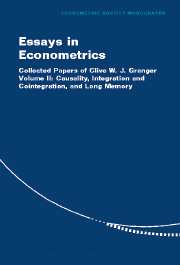Book contents
- Frontmatter
- Contents
- Acknowledgments
- List of Contributors
- Introduction
- PART ONE CAUSALITY
- PART TWO INTEGRATION AND COINTEGRATION
- 5 Spurious Regression in Econometrics
- 6 Some Properties of Time Series Data and Their Use in Econometric Model Specification
- 7 Time Series Analysis of Error Correction Models
- 8 Co-Integration and Error-Correction: Representation, Estimation, and Testing
- 9 Developments in the Study of Cointegrated Economic Variables
- 10 Seasonal Integration and Cointegration
- 11 A Cointegration Analysis of Treasury Bill Yields
- 12 Estimation of Common Long Memory Components in Cointegrated Systems
- 13 Separation in Cointegrated Systems and Persistent-Transitory Decompositions
- 14 Nonlinear Transformations of Integrated Time Series
- 15 Long Memory Series with Attractors
- 16 Further Developments in the Study of Cointegrated Variables
- PART THREE LONG MEMORY
- Index
8 - Co-Integration and Error-Correction: Representation, Estimation, and Testing
Published online by Cambridge University Press: 06 July 2010
- Frontmatter
- Contents
- Acknowledgments
- List of Contributors
- Introduction
- PART ONE CAUSALITY
- PART TWO INTEGRATION AND COINTEGRATION
- 5 Spurious Regression in Econometrics
- 6 Some Properties of Time Series Data and Their Use in Econometric Model Specification
- 7 Time Series Analysis of Error Correction Models
- 8 Co-Integration and Error-Correction: Representation, Estimation, and Testing
- 9 Developments in the Study of Cointegrated Economic Variables
- 10 Seasonal Integration and Cointegration
- 11 A Cointegration Analysis of Treasury Bill Yields
- 12 Estimation of Common Long Memory Components in Cointegrated Systems
- 13 Separation in Cointegrated Systems and Persistent-Transitory Decompositions
- 14 Nonlinear Transformations of Integrated Time Series
- 15 Long Memory Series with Attractors
- 16 Further Developments in the Study of Cointegrated Variables
- PART THREE LONG MEMORY
- Index
Summary
The relationship between co-integration and error correction models, first suggested in Granger (1981), is here extended and used to develop estimation procedures, tests, and empirical examples.
If each element of a vector of time series xt first achieves stationarity after differencing, but a linear combination α′xt is already stationary, the time series xt are said to be co-integrated with co-integrating vector α. There may be several such co-integrating vectors so that α becomes a matrix. Interpreting α′xt = 0 as a long run equilibrium, co-integration implies that deviations from equilibrium are stationary, with finite variance, even though the series themselves are nonstationary and have infinite variance.
The paper presents a representation theorem based on Granger (1983), which connects the moving average, autoregressive, and error correction representations for co-integrated systems. A vector autoregression in differenced variables is incompatible with these representations. Estimation of these models is discussed and a simple but asymptotically efficient two-step estimator is proposed. Testing for co-integration combines the problems of unit root tests and tests with parameters unidentified under the null. Seven statistics are formulated and analyzed. The critical values of these statistics are calculated based on a Monte Carlo simulation. Using these critical values, the power properties of the tests are examined and one test procedure is recommended for application.
In a series of examples it is found that consumption and income are co-integrated, wages and prices are not, short and long interest rates are, and nominal GNP is co-integrated with M2, but not M1, M3, or aggregate liquid assets.
- Type
- Chapter
- Information
- Essays in EconometricsCollected Papers of Clive W. J. Granger, pp. 145 - 172Publisher: Cambridge University PressPrint publication year: 2001
- 1
- Cited by



